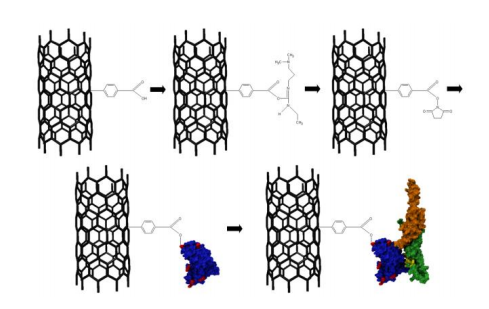Carbon Nanotube Transistors Orders of Magnitude Better at Spotting Cancer, Say Bioengineers
The early detection of many diseases dramatically improves prognoses. Prostate cancer is a case in point, with a 60 to 90 percent long-term survival rate in patients who are diagnosed at an early stage.

The problem, of course, is making such a diagnosis quickly and accurately. The standard test is for prostate-specific antigen, which is produced by a cancerous prostate in relatively high quantities.
However, the trouble with PSA tests is they produce a significant number of false positives and false negatives. So some healthy men end up undergoing invasive tests while others with the disease go undetected.
There is another biomarker of the disease known as osteopontin, or OPN. The state-of-the art technique for spotting this is known as ELISA. In this test, OPN from a sample is attached to a surface. The surface is washed with OPN-binding antibodies, which are themselves attached to colour-changing enzymes. If these antibodies bond with the OPN, the colour change can be easily detected.
But while this technique is sensitive, it is relatively time-consuming and difficult to use to quantify the amount of OPN.
So more sensitive and accurate techniques are highly sought after. Today, Mitchell Lerner at the University of Pennsylvania and a few buddies reveal just such a technique that uses an array of carbon nanotube transistors on a silicon chip to detect antigens such as OPN.
The trick they’ve perfected is a way of attaching an OPN-binding antibody to the carbon nanotube in each transistor. The electronic characteristics of the antibody-nanotube transistor can then be easily measured by the on-chip electronics.
When the chip is immersed in a sample, the OPN binds to the antibodies connected to the nanotubes, and this changes the electronic characteristics of the transistor. So measuring the current and voltage through each transistor is an accurate way of measuring how much OPN there is in the sample.
Lerner and co say their device can detect OPN at concentrations of 1 picogram per millilitre. That’s a concentration three orders of magnitude weaker than ELISA can manage.
And by replacing the OPN-binding antibody with molecules sensitive to other antigens, the carbon nanotube transistors can be made sensitive to other diseases. Lerner and co say they have successfully used the technique to detect Lyme disease and salmonella.
That’s impressive work that has the potential to improve the diagnosis and detection of many diseases and pathogens. Of course, more work is needed to characterise the behaviour of these chips and in particular the circumstances in which they might give false positives or negatives. But in the meantime, expect to hear more about them.
Refs:
arxiv.org/abs/1302.2961: Detecting Lyme Disease Using Antibody-Functionalized SingleWalled Carbon Nanotube Transistors
arxiv.org/abs/1302.2959: A Carbon Nanotube Immunosensor for Salmonella
arxiv.org/abs/1302.2958: Hybrids of a Genetically Engineered Antibody and a Carbon Nanotube Transistor for Detection of Prostate Cancer
Keep Reading
Most Popular
Large language models can do jaw-dropping things. But nobody knows exactly why.
And that's a problem. Figuring it out is one of the biggest scientific puzzles of our time and a crucial step towards controlling more powerful future models.
How scientists traced a mysterious covid case back to six toilets
When wastewater surveillance turns into a hunt for a single infected individual, the ethics get tricky.
The problem with plug-in hybrids? Their drivers.
Plug-in hybrids are often sold as a transition to EVs, but new data from Europe shows we’re still underestimating the emissions they produce.
Google DeepMind’s new generative model makes Super Mario–like games from scratch
Genie learns how to control games by watching hours and hours of video. It could help train next-gen robots too.
Stay connected
Get the latest updates from
MIT Technology Review
Discover special offers, top stories, upcoming events, and more.